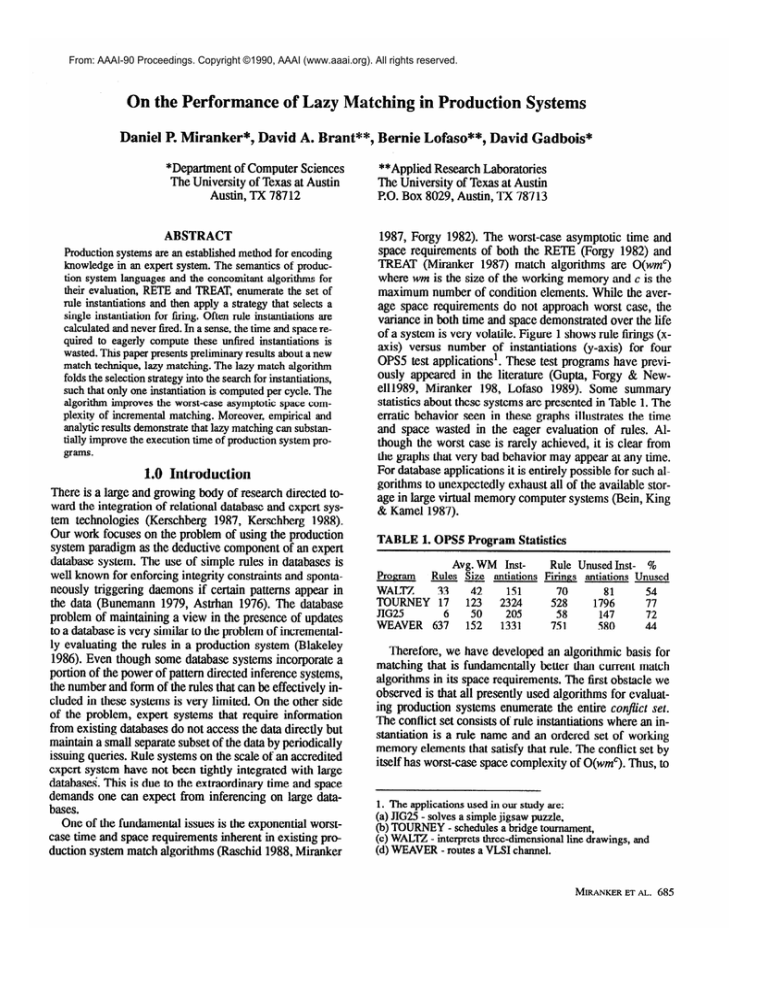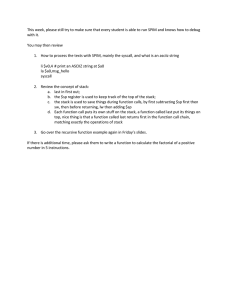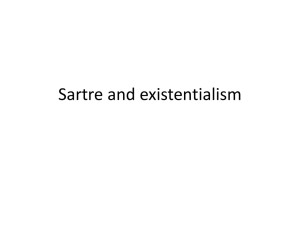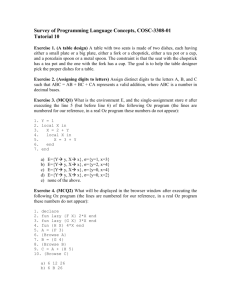
From: AAAI-90 Proceedings. Copyright ©1990, AAAI (www.aaai.org). All rights reserved.
On the Performance of Lazy Matching in Production Systems
Daniel I? Miranker*, David A. Brant**, Bernie Lofaso**, David Gadbois*
*Department of Computer Sciences
The University of Texas at Austin
Austin, TX 78712
**Applied Research Laboratories
The University of Texas at Austin
PO. Box 8029, Austin, TX 787 13
ABSTRACT
1987, Forgy 1982). The worst-case asymptotic time and
space requirements of both the RETE (Forgy 1982) and
TREAT (Miranker 1987) match algorithms are O(wm’)
where wm is the size of the working memory and c is the
maximum number of condition elements. While the average space requirements do not approach worst case, the
variance in both time and space demonstrated over the life
of a system is very volatile. Figure 1 shows rule firings (xaxis) versus number of instantiations (y-axis) for four
OPS5 test applications’. These test programs have previously appeared in the literature (Gupta, Forgy & Newe111989, Miranker 198, Lofaso 1989). Some summary
statistics about these systems are presented in Table 1. The
erratic behavior seen in these graphs illustrates the time
and space wasted in the eager evaluation of rules. Although the worst case is rarely achieved, it is clear from
the graphs that very bad behavior may appear at any time.
For database applications it is entirely possible for such algorithms to unexpectedly exhaust all of the available storage in large virtual memory computer systems (Bein, King
& Kamel 1987).
Production systems are an established method for encoding
knowledge in an expert system. The semantics of production system languages and the concomitant algorithms for
their evaluation, RETE and TREAT, enumerate the set of
rule instantiations and then apply a strategy that selects a
single instantiation for firing. Often rule instantiations are
calculated and never fired. In a sense, the time and space required to eagerly compute these unfired instantiations is
wasted. This paper presents preliminary results about a new
match technique, lazy matching. The lazy match algorithm
folds the selection strategy into the search for instantiations,
such that only one instantiation is computed per cycle. The
algorithm improves the worst-case asymptotic space complexity of incremental matching. Moreover, empirical and
analytic results demonstrate that lazy matching can substantially improve the execution time of production system progr-*
I.0 Introduction
There is a large and growing body of research directed toward the integration of relational database and expert system technologies (Kerschberg 1987, Kerschberg 1988).
Our work focuses on the problem of using the production
system paradigm as the deductive component of an expert
database system. The use of simple rules in databases is
well known for enforcing integrity constraints and spontaneously triggering daemons if certain patterns appear in
the data (Bunemann 1979, Astrhan 1976). The database
problem of maintaining a view in the presence of updates
to a database is very similar to the problem of incrementally evaluating the rules in a production system (Blakeley
1986). Even though some database systems incorporate a
portion of the power of pattern directed inference systems,
the number and form of the rules that can be effectively included in these systems is very limited. On the other side
of the problem, expert systems that require information
from existing databases do not access the data directly but
maintain a small separate subset of the data by periodically
issuing queries. Rule systems on the scale of an accredited
expert system have not been tightly integrated with large
databases. This is due to the extraordinary time and space
demands one can expect Tom inferencing on large databases.
One of the fundamental issues is the exponential worstcase time and space requirements inherent in existing production system match algorithms (Raschid 1988, Miranker
TABLE 1.OPS5 Program Statistics
Avg. WM InstRule Unused Inst- %
Rules Size antiations Firings -antiations Unused
WALTZ
42
151
81
54
TOURNEY :?
2324
5;:
123
1796
JIG25
205
58
147
7’;
WEAVER 63;
1;;
1331
751
580
44
Program
Therefore, we have developed an algorithmic basis for
matching that is fundamentally better than current match
algorithms in its space requirements. The first obstacle we
observed is that all presently used algorithms for evaluating production systems enumerate the entire conflict set.
The conflict set consists of rule instantiations where an instantiation is a rule name and an ordered set of working
memory elements that satisfy that rule. The conflict set by
itself has worst-case space complexity of O(wm’). Thus, to
1. The applications used in our study are:
(a) JIG25 - solves a simple jigsaw puzzle,
(b) TOURNEY - schedules a bridge tournament,
(c) WALn - interprets three-dimensional line drawings, and
(d) WEAVER - routes a VLSI channel.
MIRANKERETAL.
685
11
0
20
21
10
31
41
56
asymptotically improve the space complexity of the
matching problem, it is necessary to avoid enumerating the
conflict set. We have developed a new incremental match
algorithm, the lazy match, that computes a single rule instantiation per cycle, yet may maintain the present execution semantics of existing production system languages.
The lazy match is described in section 3 and has worstcase space complexity that is O(max(ts)*c). Where ts is a
timestamp and max(ts) is therefore bounded by the total
number of updates to working memory. Further, it is often
the case that instantiations are computed and placed in the
conflict set and never fired (see Table 1). The lazy match
never computes these “wasted” instantiations. Time is
wasted not only in the eager computation of unused instant&ions, but recent results have also shown that memory
management is a dominant factor in the performance of
these systems (Lofaso 1989). If memory requirements can
be reduced then we might also expect performance to improve. Section 4 presents preliminary results of an OPS5
implementation based on the lazy match. These results
show that the lazy match may substantially improve the
performance of a production system program and eliminate the need to avoid certain troublesome constructs when
writing rules. In section 2 we define production systems.
Throughout the a paper we will draw examples using the
OPS5 production system language. It is assumed that the
reader is familiar with either the RETE of TREAT incremental match algorithms.
46
000
100
wo
wo
4w
Dw
l
1 w
0
1
I*
101
lS1
PO*
PS8
301
351
409
451
SO1
TOURNEY
2.0 Production Systems and Eager Matching
180
100
940
(SO
too
80
.OD
40
IO
0
*
0
il
10
Sl
PO
30
41
46
JIG;;
Figure 1. Conflict Set Instability
686 KNOWLEDOEREPRESE~ATION
II
In general, a production system is defined by a set of rules,
or productions, that form the production memory, together
with a database of current assertions, called the working
memory (WM). Each production has two parts, the Zefthand side (LHS) and the right-hand side (RIB). The LHS
contains a conjunction of pattern elements, or condition elements (CEs), that are matched against the working memory. The RHS contains directives that update the working
memory by adding or deleting facts, and directives that
carry out external side effects such as I/O. In operation, a
production system interpreter repeats the following recog&e-act cycle:
1. Match. For each rule, compare the LHS against the current WM. Each subset of WM elements satisfying a
rule’s LHS is called an instantiation. All instantiations
are enumerated to form the conflict set.
2. Select. From the conflict set, chose a subset of instantiations according to some predefined criteria. In practice
a single instantiation is selected from the conflict set on
the basis of the recency, specificity, and/or rule priority
of the matched data in the WM.
3. Act. Execute the actions in the RHS of the rules indicated by the selected instantiations.
An OPS5 working memory element (WME) forms the
user’s conceptual view of an object and consists of a class
name followed by a list of attribute-value pairs (Forgy
1981). A class name identifies an object and the attributevalue pairs describe a particular instance of that object.
Each WME has a unique identifier (ID) associated with it.
IDS are often implemented as a strictly increasing sequence of integers-assigned when the WME was created or
last modified. They may be construed as timestamps or as
logical pointers to individual WMEs. In most production
systems, IDS are used in the conflict set resolution criteria.
Consider the WMF, shown below, used to describe a red
cube named c-l, with a mass of 100, and having a length
of 10 (attributes names are distinguished by a preceding h
operator).
(cube *name c-1 “color red *mass 100 *len 10)
A production’s LHS consists of a conjunction of CEs. It
contains one or more non-negated CEs and zero or more
negated CEs. Negated CEs are distinguished by a preceding negative sign. The LHS is said to be satisfied when:
1. for each non-negated CE, there exists at least one
matching WME, and,
2. for all negated CEs, there do not exist any matching
WMES.
Each CE consists of a class name and one or more
terms. Each term specifies an attribute within the class and
a predicate to be evaluated against the values of that attribute. A CE need not reference all of the attributes contained in its corresponding class. The class is projected
onto the named attributes in the CE. Those not named do
not affect the match criteria. Predicates consist of a comparison operator (c,>,= ,<, , or#) followed by a constant or
variable. A predicate containing a constant is true with respect to a WME if the corresponding attribute value in the
WME matches the predicate. For example, consider the
CEs and corresponding WMEs shown in Fig. 2. CE (a)
matches WMEs (1) and (3), while CE (b) matches only
WME (1).
“cube” WMEs
CEs
name color mass
1) c-1 red 6
a) (cube *mass<lO)
b) (cube Amass<10 *len>5) 2) c-2 blue 11
3) .c-3 red 1
len
8
5
3
Figure 2. Predicate Matching
The scope of a variable is the production in which it appears, and, therefore, all occurrences of a variable within a
given LHS must be bound to the same value in working
memory for the LHS to be satisfied. For condition elements containing variables, a mapping can be made to a
relational join operation. The join operator will ensure that
a given variable is consistently bound for all of its occurrences within a LHS.
2.1 Eager Matching
A critical component of any production system is the
match algorithm that computes the instantiations. Currently used match algorithms are cager in nature. If a new
WME is entered into the system they will perform a search
for all instantiations containing that WME. These instantiations are then added to the conflict set (CS). Thus, from
one rule firing to the next, the set of all valid instantiations
is preserved by making incremental changes to the CS. In
order to analyze the behavior of production systems and
their match algorithms we have- characterized them in
terms of events that can change the conflict set and the op-
erations performed by the system in response to those
events. There are five events that may result in changes to
the conflict set. Two may add instantiations. They are:2
1. make(WME+) add a WME to a class corresponding to
a non-negated CE
2. remove(WME-) remove a WME from a class corresponding to a negated CE
Three events may remove instantiations from the CS.
They are:
3. make(WME-) add a WME to a class corresponding to a
negated CE
4. remove(WIVIE+) remove a WME from a class corresponding to a non-negated CE
5. fire(I) fire instantiation I.
Current implementations of production systems perform
several basic operations in response to these five events.
For events that involve the computation of new instantiations,i.e., (1) and (2), the match algorithm effectively computes a relational database join for each rule containing the
class associated with the specified WME. The WME is
used as a seed to root the join and the join path branches
out from the seed to the other classes of the CEs for that
rule based on its join query graph. Nodes in the graph represent classes and arcs prescribe the join order. A failed
search results in a backtrack to the previous class. The
searches that succeed at the lowest level (leaf nodes of the
query graph) indicate that an instantiation was found. A
given instantiation can be represented by the timestamps
of the WMEs along the path leading from the root to the
leaf.
As new instantiations are produced the conflict set must
be resorted according to the resolution strategy. Event (3)
also results in a seed join, the results of which are removed
from the CS. Event (4) produces a search of the conflict set
for instantiations containing the specified WME, which are
then removed. Event (5) simply removes the fired instantiation from the CS.
3.0 A Lazy Matching Algorithm
The following describes a method for computing production instantiations in a lazy manner. This is accomplished
by executing a best-first search for instantiations. After
one instantiation is found, the search pauses to allow the
corresponding rule to be fired. Since the rule firing may
change WM, the best-first search must be capable of responding to a dynamic search space. This is accomplished
by maintaining a stack of best-first search pointers. As
searches are superceded by changes to the WM, their state
is pushed onto the stack. When a search is exhausted, the
next set of pointers is removed from the stack. The top of
2. Note that these events do not necessarily have a one-to-one
correspondence to the makes and removes specified in an OPS5
rule’s RI-IS, e.g., a given WME may be applicable to many CEs
and therefore an OPS5 “make” could result in numerous
make(WME+) events.
MIRANKERETAL.
687
stack always contains the state information for the next
search.
The correctness of lazy match is dependent upon being
able to enforce a total ordering in the generation of instant&ions. If this is not done, duplicate instantiations may be
computed and fired. If the total ordering is by timestamp
(i.e. ID), a search heuristic based upon firing the production with the most recent instantiation (McDermott & Forgy 1978) can be employed. However, it is important to
note that any total ordering of instantiations for a given
rule will work. Adding additional criteria for instantiations
of different rules, such as specificity and/or rule priority,
can also be accommodated in a straightforward manner?.
tion appearing at the top of the figure. Note that the timestamp is denoted as the attribute “ts”.
The computation of an instantiation begins with popping the top of stack and selecting the DT. This is followed
by a best-first search for an instantiation rooted at the
WME referenced by the DT. To ensure that instantiations
are produced only once, alpha-memories have a fixed ordering (by timestamp in this example), and the best-first
search computation restricts the WMEs joining with DT to
3.1 Conflict Set Resolution and Lazy Matching
The challenge of the lazy matching algorithm is in controlling a best-first search for instant&ions through a WM that
may change after each instantiation is found and fired. The
criteria for “best” in this case is based upon the conflict set
resolution strategies.
Lazy matching uses the selection strategy as an evaluating function to direct the search for a fireable instance.
This is done by using that criteria to direct the search for
matching WMEs from the alpha-memories4. On any given
cycle, the search for an instantiation will stop after the first
one is found, with the search being conducted so as to preserve recency. Of course, additions to, and deletions from,
the WM will affect the search, and we must ensure that a
given instantiation is fired at most once. To do so, state information is saved on a stack in order to continue the correct computation of instantiations.
Co (ts,A)
2,a,c
ILard
7,b,c
1
tiOIlS.
4. Same as the alpha-memories described by Forgy and used in
both RETE and TREAIY
688 KNOWLEDGEREPRESENTATION
6,7,6
5,5,6
4,5,4
3,3,4
32,~
60
Co(ts,A)
Cl (ts,A,B)
C2 (ts,B)
LO,
1
STACK
5,5,6
4,5,4
3,3,4
3,w
1,2,1
(W
Cn(ts,A)
Cl (ts,A,B)
C?(ts,B)
q
&arc
Lad
Lbrc
co(ts,A)
Cl(ts,A,E
STACK
4,c
5,5,6
6,~
4,5,4
3,3,4
322
vu
LO,0
Cc)
C2 (ts,B)
Lal-rr2,a,c
STACK
4,5,4
3,3,4
3,2,2
L&1
LO,0
(d)
Co (ts,A)
3. In general, the only form of conflict set resolution strategies
that cannot be done lazily are those that demand an enumeration
of the conflict set, e.g., fire the rule having the most instantia-
STACK
1,2,1
l,O,O
3.2 Computing Instantiations Using Lazy
Matching
Elements of the stack consist of a sets of pointers representing the state of a best-first search for instantiations. For
convenience we use the timestamps of the WMEs to represent both an instantiation and the search state. For simplicity of presentation we assume a single rule system. We
define an instantiation as a tuple containing one timestamp
from each non-negated CE. Thus for a rule containing n-l
non-negated CEs, stack entries and instant&ions have the
form &3(+...,t%-l>), where tsi is a timestamp. As each
WME is entered into the an alpha-memory, a corresponding initial search state is pushed onto the stack. The initial
state is <<tsg-l,...,tsi,...,ts,_1-l>>,where t% is the timestamp
of the newly added WME.
The concept of a dominant timestamp (DT) is introduced to control the lazy computation of instantiations.
For any stack entry, the DT is the most recent timestamp.
Figure 4(a) shows the initial system state for the produc-
1 C,(ts,B)
Cl O-,&B
..
Cl (ts,A,B)
C7(ts,B)
STACK
3,3,4
3,w
0l,O,O
L&1
(e)
Figure 3. Lazy Computations of Instantiations
those having timestamps less than DT. As soon as a matching set of WMEs (i.e., an instantiation) for DT is found,
the computation pauses and the result is fired. If an instantiation containing DT cannot be found, then the next stack
element is popped, and a new best-first search is begun.
When an attempt is made to pop from an empty stack the
system halts.
Figure 3(b) shows the initial state of the best-first search
pointers (pi) after the top stack entry has been popped and
the corresponding search has found an instantiation. The
best-first search is rooted at ts=7 in alpha-memory Cl and
proceeds outward in join order, most recent to least recent
WME in each alpha-memory. Thus, for Fig. 3(b) the
search state is <<3,7,6>>.
These WMEs satisfy the production and become the first instantiation. Next, the rule is
fired, and, assuming for now that no WMEs are added to,
or removed from, the WM by firing the rule, the search resumes to find the next instantiation. Figure 3(c) shows the
state of the search after finding the next instantiation <x3,7,41>.Before finding <<3,7,4>>
the search would have
tried <<
1,7,&, failed, backtracked, advanced the P2 pointer,
and succeeded (we arbitrarily chose to search the left alpha-memory first). The next time the search is performed
<x1,7,4>>
will be tried and will fail. That will exhaust the
search rooted at the DT with ts=7. At that time the next
stack entry is popped. In this case it is the WME with ts=6.
The shaded area in Fig. 3(d) contains WMEs that have
timestamps greater than that of the DT and therefore are
not considered in the search. The next instantiation to be
found is ~1,2,6>>, after unsuccessfully trying <<3,5,6>>,
<<1,5,6>>,
and <x3,2,6>>.
After that, the stack is again popped
with DT=5. Since no instantiations can be found for DT=5,
another pop is performed and the WME with ts=4 is chosen as DT. The instantiation <X
1,2,4>>is found (Fig. 3(e)) after trying <<3,2,4>>.
<<1,2,4>>
is the final instantiation that can
be produced. After it is fired, all the remaining stack entries are popped and their searches exhausted. Finally an
attempt is made to pop from the empty stack and the system halts.
We now consider the effects of adding and deleting
WMEs after each rule firing. When a new element is added
to the WM a set of initial pointers is pushed onto the stack,
but first, the current search is suspended and its state
pushed onto the stack. That search may be resumed at a
later time when it is popped off the top of stack. Since deletions may affect the state of a suspended search by removing WMEs that have pointers to them on the stack,
each time a search state is popped from the stack, its pointers must be verified by the best-first search, backtracking if
necessary. Figure 4(a) is the same as Fig. 3(b). Assume
that the instantiation referenced by <x3,7,6>>
ties and adds
the WME c8,d> to C2. This causes
1. the search state <<3,7,6>>
to be pushed to the stack,
2. <<7,7,8>>
is pushed onto the stack and subsequently
popped*
3. a best-first search is started with DT=8, and
4. the next instantiation is found. i.e.. <<1.5.8>>
IFig. 4(b)).
Co(ts,A)
Cl (ts,A,B)
STACK
C7(ts,B)
5,5,6
4,5,4
3,3,4
3,w
(a)
Co(ts,A)
Cl(ts,A,B)
L
L&1
LO,0
STACK
C2 (ts,B)
3,7,6
5,5,6
4,5,4
3,3,4
322
L2J
l,O,O
(b)
co(ts,A)
Cl (ts,A,B)
STACK
C7(ts,B)
5,5,6
4,5,4
3,3,4
3,w
(c)
123
LW
L-
Figure 4. Dynamic Search Space
Assume that firing ~1,5,8>>does not change the WM. On
the next cycle the search rooted at DT=8 will be exhausted
and the top of stack popped. Thus the search that was suspended, <x3,7,6>>,
is resumed. The next instantiation found
will be <x3,7,4>>.
The pseudocode in Fig. 5 should help elucidate the algorithm.
program Lazy Match;
Plr -l.rPn-1: WME timestamps;
begin
initialize stack;
{The top level makes that form the initial WM are added here. An entry for
each is placed on the stack.}
loop while stack not empty
pop-stack(~~, . . .,p,-lrempty);
if not empty then
best-first(pl,...,p,-l,found);
if found then
push-stack (pl, . . . ,pnwl1;
fire(pl, . . ..pn-l).
end loop;
end Lazy Match;
function pop-stack(pl,...,p,-l,empty);
{If the stack is not empty it returns
the top element and sets empty-FALSE,
else empty=TRUE}
function best-first(pl,...,p,-l,found);
{Performs a best-first search for an instantiation by working backwards from an
ordered list of timestamps.
The search
first validates the pointers then searches
using the DT as the root. If an instantiation is found then found=TRUE and the
MIRANKERETAL.
689
new
instantiation
is returned in the
*rPn-lr else found=FALSE.)
function push-stack(pl, . . ..p.-1);
{Pushes the pointers onto the stack.}
function fire(pI,...,p,-l) ;
{Fires the instantiation
referenced by
the ~1, -..rP*-1. This may alter the WM. A
make will place
an entry on top of the
stack. A remove may delete an entry from
the stack.)
Plr
- -
Figure 5. Lazy Match Pseudocode.
There are pathological cases where the best-first search
strategy will not produce the identical sequence of instantiations as OPS5. It is possible to avoid these cases by imposing a strict LEX ordering on lazy match, but doing so is
computationally expensive. Nevertheless, the criteria used
in lazy matching is in keeping with the general concept of
recency as presented in (McDermott Jz Forgy1978), and
has not yet posed a problem.
3.3 Handling Negated Condition Elements
We have discovered three different methods of lazily handling negated condition elements (NCEs). Only one will
be described here. The methods for dealing with NCEs are
closely related to the method developed for the TREAT
match algorithm (Miranker 1987). If a search for an instantiation consistently binds with a WME that matches an
NCE, then the search fails at that point and must backtrack. We say that that WME blocked the search. When a
blocking WME is removed from the system, some instant&ions may become unblocked and allowed to compete
for firing. Those instantiations that become unblocked are
those that would have been computed had the condition element been positive instead of negative, and had the WME
been added to the system instead of removed.
To handle NCEs, for each negated condition add a second alpha-memory which will shadow the first. Rename
the original alpha-memory from Ci to Ci . Call the shadow
alpha-memory e.
When a WME that has blocked a
search is removed from a C; alpha-memory it is inserted
into Csi , given the next available timestamp, and an entry
is pushed onto the stack. Note that this requires the stack to
accommodate another timestamp in its elements, one for
each shadow alpha-memory. The newly added WMEs to
CT can then be allowed to root a best-first search for those
instantiations that they had blocked.
A problem arises when a search leads to an instantiation
that has already been derived from a search rooted by a
WME in Cs . This is solved by requiring best-first search
to examine all of Ci and the portion of Ct such that a
search that starts with a DT=tst and binds consistently
with a WME in c with timestamp ts+sl fails. The idea
is that once a WME enters CSi, only it may generate instantiations with older WMEs. Such a WME will be able
to root the search for all instantiations older than itself,
whether they were blocked or not.
We can now summarize the operations performed by
lazy match and TREAT in response to the five conflict set
events (see Table 2).
690 KNOWLEDGEREPRESENTATION
TABLE 2. Events and Operations
Lazy Otxration
Event
TREAT Operation
Stack Push
Seed Join
make(WME+)
Stack Push
Seed Join
remove(WME-)
make(WME-) Seed Join & Delete from CS
None
None
Delete from CS
remove(WME+)
Best-first Search
Delete from CS
fie(T)
4.0 Preliminary
Results
4.1 Space and Time Complexity
Each alpha-memory is proportional to the size of the
WM. In the most adversarial scenario, every WME can be
added to a shadow-memory and never removed. Thus, in
the worst-case the shadow-memories are bounded by the
maximum timestamp and the worst-case space complexity
of the lazy match is O(max(ts)*c). Although the worstcase space requirements for a nonterminating program
based on this version of the lazy match are unbounded, the
worst-case is very unlikely and the space requirements of
the lazy match are not at all volatile.
We have identified several techniques that filter and reduce the size of the shadow-memories. The most aggressive of these filtering techniques bounds the size of the
shadow memories to O(wm”) where v is the number distinct positive condition elements needed to bind the variables in the shadow memory. This filter results in a worstcase space complexity of O(Min(wm’, Max(ts))*c).
A simple filter, invoked when a rule becomes inactive,
completely purges a rule’s shadow memory. A rule is active when each of its positive alpha-memories contains at
least one entry. The first filter is expensive, but effective.
The second is very inexpensive, but for some rules in a
nonterminating program it may never be invoked. Since
the shadow memories must be searched as well as the negated alpha-memories, and since there is no analog of
shadow memories in either RETE or TREAT, the actual
execution time of the lazy match must be evaluated empirically.
4.2 Implementation
To evaluate the effectiveness and the trade-off’s with respect to the variants of the lazy match we have reworked
the back-end of the OPSSc compiler to use the lazy match.
OPSSc is a portable C/Unix based OPS5 compiler originally based on the TREAT match algorithm (Miranker et
al. 1990). OPSSc produces in-line matching code for each
rule. Its target is C code which must then be compiled for
the target machine.
The recently completed current version only implements the simple purging filter on the shadow memories.
The above presentation of the lazy match considered the
generation of an instantiation by the best-first search as a
computation involving a single rule. The current implementation was extended to multiple rules by first selecting
the DT and then considering each rule/alpha-memory that
contained that DT in the order determined by the remaining conditions of the OPS5 lex strategy.
Table 3 shows the performance of the lazy match implementation with respect to OPSSc tests for three test programs. Lazy matching generally resulted in 2-3 times
fewer WME tests.
TABLE 3. WME Tests
Proaram
JIG25
TOURNEY
WALTZ
WME Tests
TREAT
LAZY
35,780
11,113
1,107;259
513;600
14.967
23.890
OPS5c has reduced the match time for these programs
to below the 90%. Therefore, speed-up may not be as high
as WME tests might indicate. The test programs in Table 3
execute very quickly and do not provide a good measure of
execution time. However, the The WALTZ program can be
scaled up by inputting larger line drawings. The original
data describe a drawing consisting of 18 line segments. To
demonstrate scaling and the effectiveness of the algorithm
on large problems, we gave it a 10,000 WME waltz problem. This resulted in a 4-fold reduction in the number of
WME tests and reduced the run time by more than 50%.
These results are much better than we expected, especially when compared to the table of unused instantiations
(Table 1) which we had thought was an optimistic measure
of pruning. Detailed examination of the programs and their
performance has revealed that lazy evaluation of certain
programming constructs commonly used in rule systems
can result in improved time complexity for the evaluation
of those constructs.
We start with an illustrative example (see Fig. 6). The
rule represents a naive one rule solution to a jigsaw puzzle
problem. This rule is typical in structure of many of the
rules in all systems we tested. This rule says, “compare all
edges to all other edges and if two have the same shape
place them next to each other”. If there are n edges, then
the TREAT algorithm will perform n2 operations.
(p one-rule-jigsaw-solution
(edge "piece-id <pidl> *edge-id <eidl>
"shape <s> "matched F)
{<Xpidl>
<pid2>} "edge(edge ^piece-id
id <eid2> "shape <s> "matched F)
-->
(write "Place puzzle piece" <pidl> "next
to piece" <pid2>")
(modify 1 "matched T)
(modify 2 "matched T))
Figure 6. Jigsaw Rule
The execution of the lazy match first picks an edge
matching the first condition element and then takes an average of n/2 operations to find the matching piece. The rule
would then fire and these two pieces would be removed
from consideration. On the next cycle the lazy match
would again pick an edge matching the first condition element and then take an average of (n-2)/2 operations to find
the matching piece. Computing the sum, from n until all
pieces are exhausted, for this rule shows that the lazy
match would execute (n2+2n)/8 operations.
We can generalize this type of problem to rules that pick
loosely restricted subsets of size k from n objects, where
loosely restricted means that oncejck objects are chosen it
will always be possible to fill the requirements for the j+l
object without backtracking. An eager evaluation of such a
rule requires O(nk) time. A lazy evaluation will take O(n)
time to pick each of k objects or O(n*k). Many systems, as
in the jigsaw puzzle, will fire such a rule until all n of the
objects have been chosen forming n/k subsets.
Theorem:
Given n WM elements. To choose n/k disjoint subsets of
size k by executing n/k cycles an eager evaluation will take
O(d) operations. A lazy evaluation will take O(n2).
Proof:
Let (r be the join selectivity. Join selectivity is the probability that the values tested for a WME will be consistent
with the values bound up to that point. For example, for
the jigsaw puzzle rule if the shape of each edge is unique
then cT=l/n.
Eagerly evaluating a rule with k conjuncts and having
each alpha-memory having n elements takes:
k
0
c
i-l,i
= 0
(nk)
(EQ1)
i=1
A Lazy evaluation takes:
(n/k)
-1
It
__
s
(k-
1) = O(n2)
(EQ2)
i= 0
Notice the constants greatly favor lazy evaluation.
How common are such rules? Rules that are completely
of this type are probably not that common. But there are
rules in nearly all systems which pairs or triple of CEs represent one of the above constructs. Any rule in any program that refers to the same class in more than one CE is a
candidate for this reduction. We have found rules of this
form in WEAVER,TOURNEY, and WALTZ. In WEAVER
there are many rules where 5 or more condition elements
refer to the same class. Our conjecture is that, using lazy
matching, there are many rules in most systems whose
time complexity will improve by one or more degrees.
5.0 Conclusions and Current Work
The idea of lazy matching is necessary to improve the asymptotic space complexity of the incremental match problem. Preliminary results show that for several application
programs Lazy matching substantially improves execution
time as well as the space requirements. Investigation of the
applications revealed that Lazily matching certain commonly used and expensive rule constructs leads to asymptotic improvement in the execution time of those rules. In
the near future we will consider rule-parallel implementations that compute one instantiation $r rule. We will also
investigate other filtering techniques-for the shadow memories, including a technique that eliminates shadow memories completely but whose worst-case space complexity is
MIRANKER
ET AL. 691
O(Max(wm”, ts)*c), and whose average space requirements are potentially volatile.
Our current goals include the development of an integrated expert-database system. By an integrated expert-database system we mean a system where working memory
encompasses a large disk resident database and conventional database transactions may occur concurrently with
the inferencing tasks. As a prototype, we are integrating
the OPS5c compiler and the Genesis extensible database
management system (Batory et al. 1988). We are exploring
the use of appropriate data structures and memory hierarchy to support this type of system. This research is being
conducted in the context of the behavior of the Lazy match
as the size of working memory is scaled to the size typical
of existing commercial databases.
REFERENCES
Astrhan, M., et. al., “System R: A Relational Approach to
Data,” ACM-TODS, June 1976.
Batory, D., et. al., “GENESIS: An Extensible Database
Management System,” IEEE Transactions on Software Engineering, Nov., 1988.
Bein, J., R. King, and N. Kamel, “MOBY An Architecture
for Distributed Expert Database Systems,” Proceedings of the 13th VLDB Conference, Brighton, 1987.
Blakeley, J. A., et. al., “Efficiently Updating Materialized
Views,” Proceedings of the 1986 ACM-SIGMOD International Conference on Management of Data,
Washington, DC, June 1986.
Bunemann, I? and E. Clemons, “Efficiently Monitoring
Relational Data Bases,” ACM-TODS, Sept. 1979.
Forgy, C., “OPS5 User’s Manual”, Tech Report CMU-CS8 1- 135, Carnegie-Mellon University, 198 1.
Forgy, C., “RETE: A Fast Match Algorithm for the Many
Pattern/Many Object Pattern Match Problem,” Artificial Intelligence, no. 19, pp. 17-37, 1982.
Gupta, A., C. Forgy, and A. Newell, “High-Speed Implementations of Rule-Based Systems,” ACM TOCS,
June, 1989.
Kerschberg, L., “Proceedings of the First International
Conference on Expert Database Systems”, Benjamin/
Cummings Publishing Company, Inc.,Menlo Park
CA, 1987.
Kerschberg, L., “Proceedings of the Second International
Conference on Expert Database Systems”, Benjamin/
Cummings Publishing Company, Inc.,Menlo Park
CA, 1988.
Lofaso, B. J., “Join Optimization in a Compiled OPS5 Environment,” Tech. Report No. ARL-TR-89-19, Applied Research Laboratories, The University of Texas
at Austin, April, 1989.
McDermott J., and C. Forgy, “Production System Conflict
Resolution Strategies,” In Pattern-directed Inference
Systems, D. Waterman and F. Hayes-Roth (eds.), Academic Press, 1978.
Miranker, D., “TREAT: A Better Match Algorithm for AI
Production Systems,” Proceedings of the 1987 National Conference on Artificial Intelligence, Seattle,
1987.
692 KNOWLEDGEREPRESENTATION
Miranker, D., “TREATA New and Efficient Match Algorithm for AI Production Systems”, P&man/Morgan
Kaufman, 1989.
Miranker, D., B.J. Lofaso, G. Farmer, A. Chandra, and D.
Brant, “On a TREAT Based Production System Compiler”, Proceedings of the 10th International Conference on Expert Systems, Avignon, France, 1990.
Raschid, L., T. Sellis, and C-C Lin, “Exploiting Concurrency in a DBMS Implementation for Production Systems,” Proceedings of the International Symposium
on Databases in Parallel and Distributed Systems,
1988.





